Community Profile: Louisiana, Mo., Survives by Adapting to Change
Photo Gallery | Article
Photo Gallery
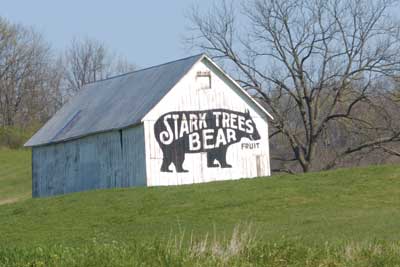
The Stark Bro’s companies in Louisiana know all about change. The nursery almost went under in 2001. But it’s going strong once again, looking forward to its 200th anniversary. (Photo by Bob McEowen, Rural Missouri)
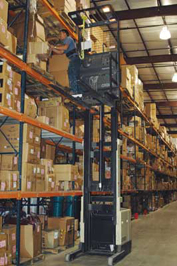
The Stark Bro's fulfillment service has taken off since being bought out of bankruptcy; it nearly doubled its warehouse capacity last year. (Photo by Jeff Guay)
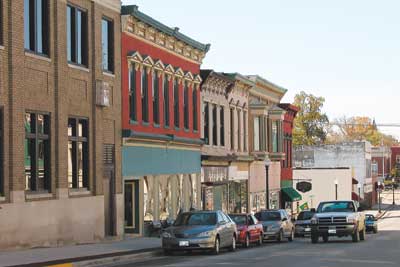
The restored downtown boasts one of the state's best collections of brightly colored Victorian storefronts. (Photo by Jeff Guay)
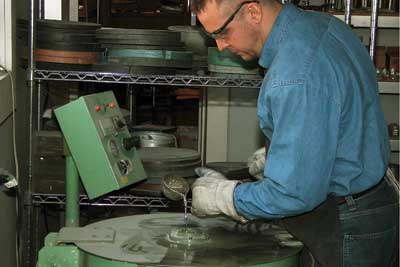
Tourists flock to see artisans at work, such as this pewter smith at the ASL Pewter shop. (Photo by Jeff Guay)

The Eagle’s Nest was once a strip of derelict buildings at downtown’s main intersection. John and Karen Stoeckley bought the buildings in 2000 and remodeled them into a bistro, restaurant, inn and winery. A few years later, Whittle Shortline Railroad moved its operations to Louisiana from St. Louis. (Photo by Jeff Guay)
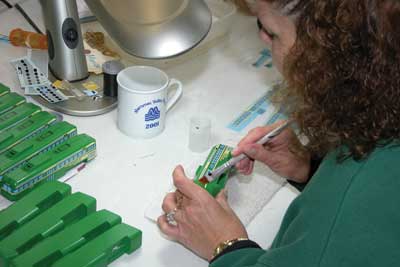
Whittle is the only U.S. manufacturer of wooden toy trains and trucks. Tourists flock to the factory store on weekends to see the toys being made. (Photo by Jeff Guay)
Don Giltner nostalgically remembers the Louisiana, Mo., of 49 years ago, when he and his wife, Priscilla, arrived in town to begin careers teaching in the public schools.
A humming local economy was reflected in a vibrant downtown, celebrated for the finest collection of Victorian commercial buildings in the state. "Every store in the downtown area was full, and every store had apartments above it, and they were full," says Don Giltner, retired from education and the town's mayor now. Townspeople gathered there Friday and Saturday nights to shop and socialize.
As years passed, roads improved. As the locals became more mobile, they gravitated for shopping to larger downtowns in Hannibal, Mo., 33 miles away, and Quincy, Ill., 47 miles away—even to the malls of the St. Louis suburbs, a smooth hour's drive away by a new four-lane highway.
By the millennium's turn, downtown Louisiana had become almost a ghost town. "There were a lot of vacant buildings, which were deteriorating," recalls Bruce Griffith, executive vice president of Louisiana's Mercantile Bank. "Year after year, one or two businesses decided to leave downtown, and we sort of hit rock bottom."
The chemical industry—consisting of the local operations of international specialty companies Hercules and Dyno Nobel—was still providing some of the town's highest-paying jobs. But technology was making it possible for both plants to sustain or increase production with fewer workers.
Dodging a Bullet
Suddenly, in June 2001, the possibility of closure came to Stark Bro's Nurseries, Louisiana's oldest and largest employer, famous worldwide for the fruit trees it grew and sold. Stark had been owned by the same local family for six generations before it was sold to an out-of-town company in the mid-1990s. When that company declared bankruptcy nearly seven years ago, Louisiana was shocked. The town's very identity was wrapped up in Stark, as were 240 full-time and about 300 part-time jobs.
The alarm was short-lived. By fall of that year, Stark Bro's was back—as two separate businesses. Thanks to employees who tended the trees for months without pay, the nurseries returned to life with at least a crop in the ground. But without phones, computers or mailing lists, "it was very much a shell of a company," says Kyle Brown, chief operating officer and son of one of the two private investors who bought the nurseries at a bankruptcy court auction.
Three years and an investment of close to $3 million put the company back on solid ground, he says, and sales are now on track to double by 2016, when the business turns 200 years old.
Meanwhile, brand new Stark Bro's Fulfillment Services has overtaken the nurseries to become Louisiana's top employer. This had been the nurseries' off-season sideline—filling orders for mail-order sellers of nonplant products. Jack Alexander, who was running the division, bought it out of bankruptcy and re-established it as a standalone company.
Alexander started in 2001 with just 50 employees. He has been hiring steadily since to keep pace with sales, which have been rising at an average rate of 30 percent a year.
The company provides stocking, order-taking, shipping and billing services for catalog marketers—seven originally, now more than 30. Their wares number 50,000 items, among them contact lenses, pet supplies, clothing, consumer electronics and greeting cards. Orders arrive at an in-house call center that operates 24 hours a day, 365 days a year. Computers track the orders every step of the way through the company's warehouses and out the doors by the truckload, bound for buyers around the world.
Expanding on Many Fronts
Late last year, Stark Fulfillment doubled its warehouse capacity by buying a building vacated by a plastics company that left town in 2006. The latter's departure was a major setback in what had been several years of community investment and economic reinvention. Over the last two years, Pike County Memorial Hospital spent $7 million on new construction and technology, and Hercules doubled its capacity.
Also late last year, St. Louis developer Keith Short opened Old Town Centre in two adjacent downtown properties, downtrodden when he bought them in mid-2005 and before he put them through a $750,000 rehab. The ground floor now consists of clothing and gift shops, and a bar that mixes more than 20 kinds of martinis. Upstairs, nine hotel rooms, the most elaborate of them with Jacuzzis and fireplaces, virtually shout "weekend getaway."
That was how John and Karen Stoeckley envisioned Louisiana back in the dark days of 2000 when they bought a strip of derelict buildings at downtown's main intersection. From those buildings, they have created the Eagle's Nest, consisting of a bistro, a restaurant, a seven-room bed-and-breakfast and a winery. The couple says their guests, daily as well as overnight, come from 100 or more miles away.
Not long after the Stoeckleys started their pioneering efforts, the downtown revival got a boost from a $275,000 state grant that the city used to resurface two streets and to install new curbs, sidewalks and street lights. A group of townspeople followed up by forming the Louisiana Economic Development Committee. Its sole purpose was to encourage new business and historic preservation in a seven-block downtown area by offering small grants to upgrade building facades. Now, standing out among the vacant and boarded-up buildings are many that are showily decked out in the eye-popping color combinations of their original era.
Cindy Blaylock, who until earlier this year headed the committee as well as the Louisiana Chamber of Commerce, says only seven or eight businesses were in the targeted area four years ago. Now, she counts 33, including professionals' offices, as well as stores selling such things as antiques, flowers, herbs and handcrafted pewter.
Luring Tourists
Downtown is a centerpiece of Louisiana's nascent new industry—tourism. The town comes with the scenic location for it—on the Mississippi River's limestone bluffs with pleasant river views from town and the river road that runs through it.
To prospective visitors, Louisiana also promotes itself as home to several artists' shops and a collection of 24 murals depicting local history. Another—and growing—attraction is Whittle Shortline Railroad, the only U.S. manufacturer of wooden toy trains and trucks. Business is booming in the wake of recent revelations about lead paint in toys made in China. Begun in a suburban St. Louis garage in 1996, the company moved production to Louisiana in 2005. Visitors can watch the toys being made and buy them at a factory store.
"We've had weekends when we've had 100 families coming through the shop," says President Mike Whitworth. Griffith says he has been noticing a general pickup in weekend traffic and in people buying second and retirement homes around town.
Importing Skilled Workers
Louisiana is home to the greatest concentration of people and businesses in otherwise thinly populated Pike County. The county is a good source of the hourly, unskilled workers tourism generally demands but is without a ready pool of professionals or skilled craftsmen.
W.C. Crenshaw, manager of the Hercules plant, says he recruits all professional and technical employees from out of town. Stark Nurseries' Brown says that all of his information technology staffers live in St. Louis and commute daily to their jobs.
Similarly, Giltner says, the contractors on the town's proposed trash-to-energy plant would probably have to import their 150 to 200 construction workers from St. Louis. The project has been on Louisiana's horizon for several years, since the seven-county Mark Twain Solid Waste Management District set up a nonprofit corporation to make it happen.
The incinerator would replace an obsolete coal-fired burner used by the adjacent Hercules and Dyno Nobel plants with a source of cleaner, lower-cost power. Hercules has donated 171 acres for the plant, which would cost about $150 million and be financed with revenue bonds. Construction, which could start later this year, is expected to take 1½ to two years.
The new plant is expected to employ about as many people as the old one, producing no immediate net increase in local employment.
For that, the city has been looking to some extent to an eight-year-old industrial park, which has only two tenants now and 50 of its 62 acres still available. Giltner sees the separate incinerator property as providing "an incentive for other industries or corporations to locate around it so that they can buy the power from it."
He also envisions it conveying an important economic message about Louisiana: "Even though we're a small community and kind of laid back, we're not afraid of change at all. In fact, we will embrace change and the new technology."
Louisiana, Mo. by the numbers
| Population | 3,831* |
| Pike County population | 18,566* |
| County labor force | 8,580** |
| County unemployment rate | 5.4 percent** |
| County per capita income | 21,568*** |
| *2006, U.S. Census Bureau | |
| **December 2007, Bureau of Labor Statistics | |
| *** 2005, Bureau of Economic Analysis | |
| Top Employers (by full-time workers) | |
| Stark Bro's Fulfillment | 280* |
| Stark Bro's Nurseries | 200** |
| Pike County Memorial Hospital | 175 |
| Hercules Inc. | 130 |
| Allparts Inc. | 85*** |
| Dyno Nobel | 80 |
| all self-reported 2008 | |
| *Plus approximately 70 part-timers during busy season | |
| **Plus approximately 50 part-timers during busy season | |
| *** A distributor of brake parts for the automotive aftermarket | |
Views expressed in Regional Economist are not necessarily those of the St. Louis Fed or Federal Reserve System.
For the latest insights from our economists and other St. Louis Fed experts, visit On the Economy and subscribe.
Email Us

